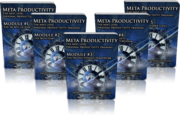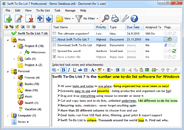This technique comes from the “Happiness” chapter in the book 59 Seconds, which is a very unique self-help book – everything in it is backed by peer-reviewed scientific research. The chapter on happiness is especially intriguing, because the techniques suggested in it are far simpler than anything else I’ve seen that’s supposed to increase your level of happiness. I’ve personally tested this and I can confirm that it works. I just feel great, and so can you.
We struggle to build our businesses and personal empires every day, and yet, there are far easier and simpler ways to attain happiness now. And what’s more, this gained happiness will help us in our daily quest for glory – numerous scientific studies have proven that happiness doesn’t come from success, it actually causes it.
Happiness has many benefits – more successful professional life, better personal life and relationships, better health… but most importantly, happiness is the ultimate goal by itself. When you ask anyone in the world what they want in life, the answer will always be “happiness”.
Studies have also discovered that happiness will make you:
- More sociable
- More altruistic and kind
- Like yourself more
- Like others more
- Able to resolve conflicts easily
- Have stronger immune system
In the end, it will bring you more satisfying relationships, great career, and longer healthier life.
Money helps, but it won’t make you happy
Another study, done by Philip Brickman, has proven that money doesn’t bring happiness. When lottery winners were enquired about the happiness in their lives, they weren’t happier than regular people in the control group. In fact, people who won the lottery derived less pleasure from simple things in life.
Studies have also shown that higher income doesn’t help either – once you can afford the necessities in life, an increase in income doesn’t result in a considerably happier life.
The reason behind this is that we get used to what we have very quickly. Getting new stuff gives you a short-term boost of good feelings, but you get used to it quickly and sink back to your pre-purchase level of happiness. Yesterday luxuries can soon become today’s necessities and tomorrow’s relics.
So, how to bring a permanent smile to your face, when money isn’t the answer?
Unfortunately, 50 percent of our overall sense of happiness is genetically determined. 10 percent of our happiness is due to general circumstances (education, income, relationship status). But the great news is that 40 percent of our happiness is derived from the day-to-day behavior and the way we think about ourselves and others. It is easy to change this 40 percent and become significantly happier quickly.
The popular advice is to think positive. Positive thinking may be helpful, but definitely not when you just try to suppress your negative thoughts. Not only it doesn’t work, it will make you feel even worse. Distracting yourself is a bit better, but it’s not the solution either. For long-term sense of happiness, research suggests that you need to know how to write, do small acts of kindness, and change your attitude to feel more grateful.
Writing will make you happy, talking won’t
Majority of people think that talking about negative or traumatic experiences with others will make them feel better. However, the reality begs to differ – venting your emotions and sharing your pain won’t make you feel any better. It won’t affect how you feel in a week at all. So, if talking to others about your negative experiences is mostly a waste of time, what can you do to actually feel better permanently?
One proven option involves “expressive writing”. Studies have shown that by writing your thoughts about the negative events in your life for just a couple of minutes each day can not only make you feel better, but even improve your health, and increase your self-esteem.
See my previous post on freewriting – combining these 2 techniques can be especially powerful!
The obvious question is – why talking about a traumatic experience has no effect, but writing about it yields such beneficial results?
The reason behind this is that talking and writing are very different. Talking is unstructured and chaotic, while writing is structured and leads you towards solutions. Talking can make you even more confused, but writing helps you to organize your thoughts and has a big solution-bias.
So, now we know that writing your thoughts is helpful for those who have experienced a trauma in their life, but how about using this idea to promote everyday happiness? Science says it’s indeed possible.
The Gratitude Attitude
Whenever you are exposed to anything for a longer period of time, it will eventually disappear from your awareness.
We all have something to be happy about. Perhaps a loving partner, good health, great kids, satisfying job, close friends, interesting hobbies, caring parents, roof over our heads, clean water to drink, great collection of music CDs, or enough food to eat.
However, as time goes, we get used to what we have, and all these wonderful things disappear from our minds.
To put it another way – you don’t know what you’ve got till you lose it.
Researchers have wondered what would happen if people were reminded of the things that they should be happy about – they asked 3 groups of people to write weekly. The first group was told to list 5 things they are grateful for, the second group listed 5 things that annoyed them, and the third group listed 5 events that have happened during the past week.
The results were very interesting. Compared to the annoyance group and events group, the people in the gratitude group ended up happier, more optimistic about the future, healthier and even exercised much more.
Your ideal future
Research shows that although mere visualizing of a wonderful future is unlikely to increase your chances of achieving your goals, it can make you really happy.
Studies have shown that imagining your ideal future or describing the most wonderful experiences from your past, for just a few minutes each day, will make you significantly happier.
Affectionate Writing
Being in a loving relationship is good for your physical and psychological health – that’s probably no surprise. However, are these benefits the result of receiving love, expressing love, or both?
A study has shown that by spending 20 minutes thinking and writing about someone loved, and describing why this person means so much to you, once a week, will increase your happiness and reduce your stress and cholesterol levels.
To happiness through writing
To sum it up, certain types of writing can lead to long-term everyday happiness. Expressing gratitude, thinking about a wonderful future, and affectionate writing about a loved one have been scientifically proven to work. All it takes is just a piece of paper and a pen (or a text editor), and a few moments of your time.
Incorporating happiness writing into your life
You can attain greater levels of lasting happiness by writing a special happiness journal. This journal should be completed on five days of the week; each entry should take just a few moments. After finishing the journal, you should quickly notice the difference in mood and happiness. These changes may persist for months. Repeat the exercise if you feel the effects wearing off.
Monday: Gratitude
List three things that you are grateful for. It could be anything – your family, friends, home, food, smile of a stranger, your dog, lovely cup of coffee, flowers, birds singing outside, good health. Think back over the past week and list three things.
Tuesday: Wonderful Memories
Think about one of the happiest moments in your life. Choose just one experience and relive the moment. Imagine how you felt, and make the vision as vivid as possible. Now write about that experience and how you felt. Don’t worry about grammar, spelling, etc.
Wednesday: Fantastic Future
Write about your life in the future for a few moments. Imagine that everything has gone really, really well. Be realistic, but imagine that you’ve worked hard and thus achieved your goals. Imagine you have become the person you want to be, and everything feels like a dream come true.
Thursday: Affection
Choose one person in your life who is very important to you. Your partner, close friend or family member. Write a short letter to this person, describing how much you care for them and how important they are for you. Write it like it was the only chance to express your feelings to them you will have. (There is no need to actually send the letter; it’s simply another part of your personal happiness journal.)
Friday: Happy week in hindsight
Think back over the past seven days and write about three things that went well for you. It doesn’t matter if they are trivial or important.
I personally use our very own Swift To-Do List to keep the happiness journal. The memo feature is perfect for it.
You won’t realize how great your life is, right now, until you try this.





